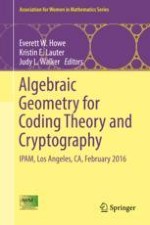Covering topics in algebraic geometry, coding theory, and cryptography, this volume presents interdisciplinary group research completed for the February 2016 conference at the Institute for Pure and Applied Mathematics (IPAM) in cooperation with the Association for Women in Mathematics (AWM). The conference gathered research communities across disciplines to share ideas and problems in their fields and formed small research groups made up of graduate students, postdoctoral researchers, junior faculty, and group leaders who designed and led the projects. Peer reviewed and revised, each of this volume's five papers achieves the conference’s goal of using algebraic geometry to address a problem in either coding theory or cryptography. Proposed variants of the McEliece cryptosystem based on different constructions of codes, constructions of locally recoverable codes from algebraic curves and surfaces, and algebraic approaches to the multicast network coding problem are only some of the topics covered in this volume. Researchers and graduate-level students interested in the interactions between algebraic geometry and both coding theory and cryptography will find this volume valuable.
